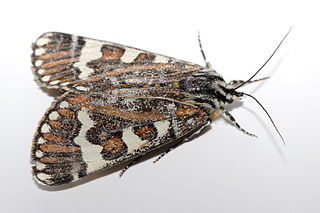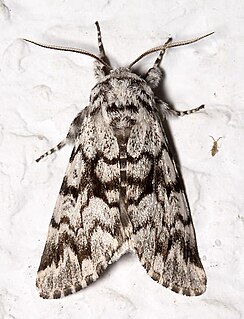Related Research Articles

The pasture day moth, Apina callisto, is a species in the moth family Noctuidae which is active during the day, as its common name implies, making it unlike most other noctuid species. It is found in most southern areas of Australia, ranging from lower Queensland to Tasmania. The species was first described by George French Angas in 1847. It is the only species in the monotypic genus Apina, erected by Francis Walker in 1855.

Orthonama obstipata, the gem, is a moth of the family Geometridae. The species was first described by Johan Christian Fabricius in 1794. It is a cosmopolitan species. In continental Europe though in the northeast, its range does not significantly extend beyond the Baltic region and it is absent from northern Russia. This well-flying species is prone to vagrancy and able to cross considerable distances of open sea; it can thus be regularly found on the British Isles and even on Iceland.

Epicallia villica, the cream-spot tiger, is a moth of the family Erebidae. The species was first described by Carl Linnaeus in his 1758 10th edition of Systema Naturae. It is distributed from the Iberian Peninsula across western and southern Europe, Anatolia, western and northern Iran, western Siberia, southwestern Asia and North Africa.

Nepita is a monotypic moth genus in the subfamily Arctiinae erected by Frederic Moore in 1860. Its only species, Nepita conferta, the footman moth, was first described by Francis Walker in 1854. It is found in India and Sri Lanka.

Carmara is a monotypic moth genus of the family Noctuidae. Its only species, Carmara subcervina, is found in Sri Lanka, Japan, Taiwan, Borneo and Australia. Both the genus and species were first described by Francis Walker in 1864.

Panthea acronyctoides, the black zigzag or tufted spruce caterpillar, is a moth of the family Noctuidae. The species was first described by Francis Walker in 1861. It is found in North America from Newfoundland to British Columbia and adjacent northern states, south in the west to Colorado, south in the east to New England and Kentucky.

Eudocima materna, the dot-underwing moth, is a moth of the family Erebidae found in widespread parts of the world, mainly in tropical Asia extending to New Guinea and Australia as well as in Africa. Reports from the United States, Canada and the French Antilles are now considered to be Eudocima apta. The species can be differentiated from other Eudocima moths by the presence of small central black dot in each hindwing. The species was first described by Carl Linnaeus in his 1767 12th edition of Systema Naturae.

Spodoptera mauritia, the lawn armyworm or paddy swarming caterpillar, is a moth of the family Noctuidae. The species was first described by Jean Baptiste Boisduval in 1833. Able to eat many types of food, it is a major pest throughout the world.

Athetis reclusa is a moth of the family Noctuidae first described by Francis Walker in 1862. It is found from Sundaland to New Caledonia and Fiji. The habitat consists of open areas from sea level up to 1,200 meters.
Anomis combinans, the yellow-banded semi-looper moth, is a moth of the family Erebidae. The species was first described by Francis Walker in 1858. It is found in Australia, Sri Lanka, Borneo, New Guinea, Malaysia and Timor.
Nygmia xanthomela is a moth of the family Erebidae first described by Francis Walker in 1862. It is found in Sri Lanka, Borneo, Java, Sumatra and Peninsular Malaysia.
Lymantria marginata is a moth of the family Erebidae first described by Francis Walker in 1855. It is found in India, Bangladesh, Sri Lanka and Thailand.

Aegilia describens is a moth of the family Noctuidae first described by Francis Walker in 1858. It is found in Oriental tropics of India, Sri Lanka, to New Guinea, the Bismarck Islands and Queensland, also on Christmas Islands in the Indian Ocean.

Polytela gloriosae, the Indian lily moth or lily caterpillar, is a moth of the family Noctuidae. The species was first described by Johan Christian Fabricius in 1781. It is found in Sri Lanka, India and probably in Indonesia.

Maceda mansueta is a moth of the family Nolidae first described by Francis Walker in 1857. It is found in Japan, Sri Lanka, Borneo, India (Andamans), Malaysia, New Guinea, Fiji, Australia, Réunion and the Seychelles.
Maurilia iconica is a moth of the family Nolidae first described by Francis Walker in 1857. It is found in Indo-Australian tropics of Sri Lanka, Australia to the islands of Samoa, Rarotonga and New Caledonia.
Lasiolopha saturata is a moth of the family Nolidae first described by Francis Walker in 1865. It is found in Oriental tropics of India, Sri Lanka, Thailand, New Guinea and Australia.

Earias cupreoviridis, called the cupreous bollworm as a larva, is a moth of the family Nolidae. The species was first described by Francis Walker in 1862. It is found in African countries like Botswana, the Democratic Republic of the Congo, Eritrea, Ethiopia, the Gambia, Kenya, Nigeria, Sierra Leone, South Africa, Togo, Uganda, Zimbabwe to Asian countries like India, Sri Lanka, China, Japan, Korea, Philippines, Indonesia and Hong Kong.
Beara dichromella is a moth of the family Nolidae first described by Francis Walker in 1866. It is found in Sri Lanka, and India.
Nola analis is a moth of the family Nolidae first described by Wileman and West in 1928. It is found in India, Sri Lanka and Hong Kong.
References
- ↑ "Species Details: Barasa acronyctoides Walker, 1862". Catalogue of Life. Retrieved 12 November 2018.
- ↑ Koçak, Ahmet Ömer; Kemal, Muhabbet (20 February 2012). "Preliminary list of the Lepidoptera of Sri Lanka". Cesa News. Centre for Entomological Studies Ankara (79): 1–57 – via Academia.
- ↑ Savela, Markku. "Barasa acronyctoides Walker, 1862". Lepidoptera and Some Other Life Forms. Retrieved 15 November 2018.
- ↑ "Barasa acronyctoides Walker". The Moths of Borneo. Retrieved 12 November 2018.